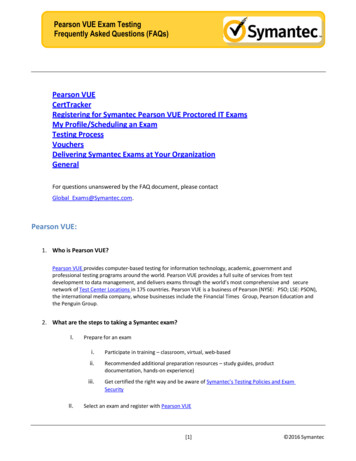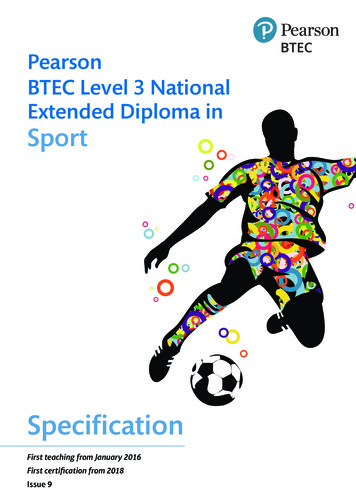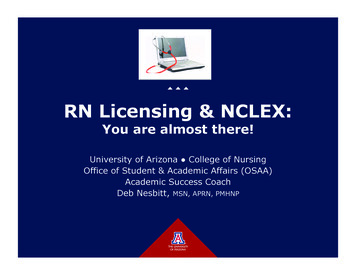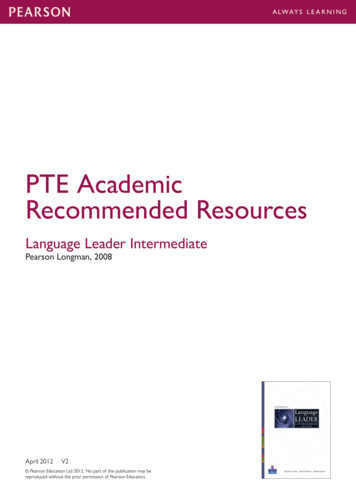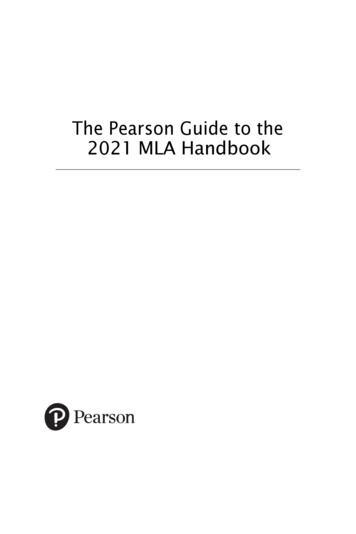
Transcription
The Pearson Guide to the2021 MLA Handbook
2The Pearson Guide to the 2021 MLA HandbookCopyright 2021 Pearson Education, Inc.All Rights Reserved. Printed in the United States of America. This publication isprotected by copyright, and permission should be obtained from the publisher prior toany prohibited reproduction, storage in a retrieval system, ortransmission in any form or by any means, electronic, mechanical, photocopying,recording, or otherwise. For information regarding permissions, request forms and theappropriate contacts within the Pearson Education Global Rights & PermissionsDepartment, please visit www.pearsoned.com/permissions/.References to the Modern Language Association and the Ninth Edition of the MLAHandbook are not intended to imply any sponsorship, endorsement, authorization, orpromotion of Pearson's products by the Modern Language Association, or anyrelationship between the Modern Language Association andPearson Education, Inc., or itsaffiliates, authors, licensees, or distributors.
3ContentsQuick Start Guide5Visual Guide to an MLA Citation71 What Is MLA Documentation Style?82 The Basic Principles of Documenting10Understanding Plagiarism10The Ethics and Conventions of Academic Research11Quoting, Paraphrasing, and Summarizing12Understanding Principles of Inclusive Language153 A Three-Step Process for Documenting Sources171. Think: Evaluating Your Sources172. Select: Gathering Information about Your Sources203. Organize: Creating Your Documentation224 Creating Your Works-Cited List23The Core Elements23Template for works-cited entries25Example: Book25Example: Article in a scholarly journal25Example: Article in an online newspaper26Example: Article in a scholarly journalfound in a database27Detailed GuidelinesAuthor2828
4Title of source29Title of 33Publication date33Location345 Creating In-Text Citations37In-Text Citation37Works-Cited Entry37Special Situations396 Researching Online: Special Cases and Examples42Google Scholar42Library Databases43Images and Media44Citations in Multimedia Projects457 Sample Works-Cited List46
5Quick Start GuideTo use MLA style to document a source, follow these steps.1. Evaluate your sourceYou have found a passage in a report, and you want to use part of it ina research project:Increasingly, the arts have become more widely established andaccepted as health-promoting practices in the United States andaround the world. As the U.S. healthcare system moves towardgreater integration of physical and behavioral health, arts-basedinterventions should be considered among potential complementaryapproaches for managing pain and preventing and treating substanceabuse disorder.The passage supports your argument, and the report is authored andpublished by a U.S. government organization, so you decide to use it inyour project.2. Gather information about the sourceAuthor:National Endowment for the ArtsTitle:Arts Strategies for Addressing the Opioid Crisis: Examiningthe EvidenceContainer (information about where you found the source; inthis case, an online report that is downloadable as a PDF):National Endowment for the Arts, Oct. 2020, tegies-Opioid-Crisis.pdf.
63. Create your documentationA citation in MLA style has two components. The first is an entry in a listof works cited that appears at the end of your paper or project:National Endowment for the Arts. Arts Strategies for Addressing theOpioid Crisis: Examining the Evidence, Oct. 2020, pp. 1–98. NEA,https://www.arts.gov/sites/default/ files/Arts-Strategies-OpioidCrisis.pdf.The second component is an in-text reference. Any quotation, paraphrase,or summary of words or ideas from a source needs to be noted in the bodyof your paper, as in this example:There is growing evidence that the arts have healing powers, and thatmusic, in particular, can help prevent and treat substance abuse andeven manage chronic pain (National Endowment 7).Every citation in MLA style builds on this basic pattern. This guideprovides additional details to help you feel confident about using MLAdocumentation in your writing and other research projects.
7Visual Guide to an MLA CitationauthortitleGay, Roxane. “A Year Without Our Work Friends.”containerThe New York Times, 6 Mar. 2021, -gay-work-friend-work-fromhome.html.An MLA citation has three basic parts—the author’s name, the title of thesource, and the container.Author’s name. In this example, the author is an individual,Roxane Gay.Title of source. If a work is part of a larger whole (such asan article in a magazine, an essay in an anthology, or apoem in a collection), its title is placed inside quotationmarks, as shown in the example above. Titles of selfcontained or stand-alone works (such as novels) areitalicized.Container. A container is the larger whole in which thesource is found. A container can be a journal, a website,a database, a newspaper, and so forth. In this example,the container is The New York Times website. (You can tellthis article comes from an online newspaper because thecitation includes a URL. Print newspapers include a pagenumber instead.) Note that sources can (and often do),include more than one container.This guide includes information about many details of the MLA works-citedformat. If you remember these three basic parts, you can apply them tocreate a citation for just about any type of source.
81What Is MLA Documentation Style?MLA is an abbreviation for Modern Language Association, an organizationof teachers and scholars in language and literature. As a scholarlyorganization, MLA establishes standards and guidelines that authors andeditors follow in their writing. These standards, or conventions, are designedto create uniform, consistent ways of handling the details of format andstyle used in published research.The MLA Handbook is a guide to writing with sources that has been usedby students and teachers in rhetoric and writing courses for many years.In 2021, MLA published the ninth edition of the Handbook, offeringupdated advice and models for documenting the wide range of constantlyevolving sources that writers encounter today. Whether you need to cite ajournal article from a database or a post from Instagram, this guide, basedon the 2021 edition of the MLA Handbook, will keep you current and up tospeed with the latest guidelines.MLA style can be contrasted with APA or Chicago style. MLA is usedprimarily in English and the humanities; APA is used in the social sciences(including psychology and communication); and Chicago style is used inhistory and the arts. Other common documentation styles used in collegecourses include APSA (political science), CSE (natural sciences), and IEEE(engineering and computer science).As a college student, you are expected to apply high standards to your ownwriting and research. You are a member of a scholarly community, and youare participating in academic conversations in your classes and in yourwriting. Learning to use MLA style is one way to show your readers thatyou take yourself seriously as a writer and a researcher, and demonstrating
9your mastery of the elements of MLA style helps build credibility for yourwork.During your college career, you may need to learn two or three differentdocumentation styles. While the details vary from one style to another, thegeneral principles of documenting sources and giving credit to others fortheir words and ideas form the foundation of any academic style. LearningMLA style will help you adapt to other styles you may be asked to use inother courses.
102The Basic Principles of DocumentingAny time you borrow the words or ideas of others, you need to documentthe source from which you are borrowing. Documenting is a way of givingcredit for ideas and expressions that others have created.Academic writing is a kind of conversation. You are sharing your ideaswith your readers, and you are also engaging in a conversation with thesources you read and use in your work. In a social setting, you wouldn’ttell someone else’s story and pretend it was your own; in an academicenvironment, you are similarly responsible for noting when you are usingsomeone else’s words or ideas. The basic principles of documentation alsoapply to visual sources, like photographs and videos, and to music andother media as well.Many college students are very aware of and concerned about plagiarism.Campus orientations and first-year-experience courses often devotesubstantial time to explaining the possible penalties for plagiarizing,including failing grades and even suspension. This chapter covers someof the basics to help you know how best to document sources and avoidplagiarizing unintentionally. The most important principle is this: When indoubt, document!UNDERSTANDING PLAGIARISMPurchasing a paper from an online research-paper service and turning itin as your own. Cutting and pasting sections from a friend’s research essayinto yours. Copying chunks of material from a website and inserting theminto your own paper. All of these are obvious, intentional acts of plagiarismthat you would never willingly commit. Blatant, intentional plagiarism ofthis kind is relatively rare—and also rather easy to detect. Teachers can
11access online sources just as instantly as students, and it doesn’t take mucheffort to find original passages that have been copied into a student’s paper.But what about subtler, unintentional plagiarism? How can learning to useMLA and other documentation styles help you avoid that? Most studentswho wander into unintentional-plagiarism territory do so for one oftwo reasons: Either they forget to take good notes and keep track of theirsources, or they misrepresent someone else’s ideas as their own by failing todocument properly.THE ETHICS AND CONVENTIONSOF ACADEMIC RESEARCHAt the beginning of a research project, you are likely to be working quicklyto find and collect sources you might use. Whether you use a papernotebook, digital files, or bookmarked websites—or all of the above—besure to immediately capture all the information you need to cite eachsource. That way, you won’t put yourself in a bind later when you have thatperfect quote for your project, but you don’t remember where it came from.Digital note-taking apps such as Microsoft OneNote can be helpful. Youcan save, tag, and organize articles, web pages, images, audio, video,and other materials, and store them along with the information aboutthe author, title, publisher, dates, and so forth—all in one place. If youprefer to work on paper, by downloading and printing copies ofsources, be sure to note the author, title, and source of the publicationon each printout.When taking notes or capturing information from online sources, beespecially careful to note the exact location as you find each source. Copythe complete URL for each online source from your browser bar and pasteit into your notes. Mark words that are copied directly from a source byputting quotation marks around them, or by highlighting them in a color,or in a different typeface. You want to be sure to differentiate words youhave borrowed directly from sources and words that represent your ownnotes or summaries.Being meticulous and detail oriented as you gather sources is one way youare participating in the academic community. Academic research andscientific knowledge can grow and develop because researchers build on thework of others. One of the foundations of academic research is a respect forthe work that others have done to pave the way. Taking a little time to record
12information about a source when you find it can save you a lot of time later,too.QUOTING, PARAPHRASING, AND SUMMARIZINGSources can be used in a research paper or project in several different ways.If you want to use the exact words you found in a source, use quotationmarks to indicate which words are borrowed from the source. If you wantto capture the general ideas from a source but use your own words, usewhat is known as a paraphrase. Paraphrasing means restating someone else’sideas in your own words. A paraphrase is usually about the same length asthe original source. If you want to capture the main idea of a source in aconcise restatement, use a summary. Summaries are usually much shorterthan the original source. Sometimes you might even summarize an entirearticle in a single sentence.Direct quotations, paraphrases, and summaries all need to be documented.Even if you restate another author’s ideas in your own words, you still needto credit that author as the original source of the ideas and concepts you areusing.Consider some different ways you might use the excerpt below, from thereport by the National Endowment for the Arts (NEA).Increasingly, the arts have become more widely established andaccepted as health-promoting practices in the United States andaround the world. As the U.S. healthcare system moves towardgreater integration of physical and behavioral health, arts-basedinterventions should be considered among potential complementaryapproaches for managing pain and preventing and treating substanceabuse disorder.Suppose you decided to restate the NEA’s ideas in this sentence andinclude it in your paper:In the context of U.S. healthcare practices, using the artsto promote physical and mental health can help peoplemanage pain and addiction.
13Do you need a citation? All of the ideas have been rewritten in your ownwords. But in the absence of a visible citation, this sentence would beplagiarism. The ideas are borrowed from the NEA, and you need to signalthat to your readers. You could do this in several ways. Add an introductory signal phrase and parenthetical citation:signal phrase names authorThe National Endowment for the Arts asserts that, in thecontext of U.S. healthcare practices, using the arts topromote physical and mental health can help peoplemanage pain and addiction (7).parenthetical citation gives locationYou are still using a summary written in your own words, but you clearlysignal that the ideas come from the NEA, and the in-text reference at theend tells readers exactly which page in the NEA source you wereconsulting at the time. Incorporate a direct quotation and a signal phrase:The National Endowment for the Arts, an agencydedicated to connecting Americans with the benefits ofcreativity, argues that the healthcare system shouldincorporate “arts-based interventions” as a possible toolfor “managing pain and preventing and treating substanceabuse disorder” (7).In this passage, the introductory phrase clearly signals that the ideas aredrawing on the work of the NEA, and the quotation marks indicate thewords that have been copied exactly from the original source. Theparenthetical reference at the end tells readers that the quoted words may befound on page 7 in the NEA source. Incorporate a longer direct quotation and name the author in aparenthetical citation:Americans may benefit from therapies that incorporate creativeapproaches. One report documenting the use of music as treatmentasserts: “As the U.S. healthcare system moves toward greaterintegration of physical and behavioral health, arts-based interventions
14should be considered among potential complementary approaches formanaging pain and preventing and treating substance abuse disorder”(National Endowment 7).Here, the phrase “one report” clearly tells readers that you are drawing onsomeone else’s ideas. The quotation marks show which words are copiedfrom the source, and the author’s name and page number are included inthe parenthetical reference at the end.MLA style gives you several options for integrating sources into your paperand documenting them clearly and efficiently. If you are unsure aboutwhether your sources are documented properly, ask a friend to read a draftof your paper and underline or highlight any places where you haveborrowed ideas or words from another person. If your friend can’t seewhich ideas are yours and which are borrowed, then you need to makesome revisions using some of the strategies in this section.For all of the examples shown here, you would also need to include acomplete citation for the NEA source at the end of your paper, like this:National Endowment for the Arts. Arts Strategies for Addressing theOpioid Crisis: Examining the Evidence, Oct. 2020, pp. 1–98. Strategies-OpioidCrisis.pdf.
15UNDERSTANDING PRINCIPLES OF INCLUSIVE LANGUAGEAs you draw on sources in your paper—quoting, paraphrasing, andsummarizing them—follow these tips for using language that isrespectful to your source authors and readers. Refer to a person’s identity only if doing so is relevant to thecontext:The female coach, who led her team to a nationalchampionship, had been underestimated by her malecounterparts. Avoid generalizing about a person or group:Muslims believe that . . .A Muslim belief is that . . . Use language that reflects a person’s or group’s identitypreferences (using person-first language or identity-firstlanguage, depending on context). person-first:person with ADHDpersons with disabilities identity-first (that is, the person communicates that theyidentify as such):queer persongender fluid person Check your style.Review your writing for words that identify people in terms ofrace, social class, gender, sexual orientation, and otherdescriptors. Check your dictionary to determine whether tocapitalize or lowercase a term (e.g., Black, atheist, etc.). If yourdictionary offers both options, choose one and use it consistently. Use inclusive pronouns.Not everyone identifies as female or male. For this reason, it’s a
16good idea to avoid pronouns, such as his or her, that may excludea portion of your readers. You can fix this by rewriting yoursentence so that it does not contain pronouns:Each player has his or her own style.Each player has a unique style.Another option is to use the singular pronouns they or their:Each player has their own style. Do not make assumptions.While it may be easy to think that readers are “just like us,” thereality is audiences are diverse in terms of identity, beliefs, andother factors. For this reason, avoid terms (such as we and our)that exclude:“As a culture, we . . .”“Our values dictate that . . .”Further, when describing people, especially persons withdisabilities, avoid using terms that convey a judgment of theirexperience (such as suffers from):suffers from a mental illnesshas been diagnosed with a mental illness Check your work for offensive words.Because language changes constantly and in relation to humanexperience, Merriam-Webster identifies a “new word of the year”each January. Over time, the connotations (suggested meanings)of words change. For example, as the editors of MLA 9e pointout, the disparaging term “Gypsy” was once widely used todescribe the Romani (or Roma) people. Avoid such terms unless1) they reflect the language of an original source (set them inquotation marks); or 2) they are essential to your point (in thiscase present the first letter followed by dashes).
173A Three-Step Process forDocumenting SourcesDocumenting sources is a mindset as well as a process. A research mindsetinvolves careful attention to each source you find: What is this? Whowrote it? Does it have an agenda or a commercial purpose? Can I trust thisinformation?Research, inquiry, and critical thinking are vital strategies for any field ordiscipline. Information literacy is a highly valued set of interrelated skillsthat you will want to cultivate throughout your college career and beyond.These topics extend far beyond what can be covered in this brief guideto MLA documentation. But we can outline a basic process that you canapply and adapt to your own workflow and writing style as you conductresearch and document sources. This three-step process follows the modeloutlined by the MLA in the ninth edition of its handbook. Notice that, in thismodel, documenting sources is not something to be done at the end of theprocess, when formatting a final list of works cited; it is something to be keptin mind from the very beginning of any research process.1. THINK: EVALUATING YOUR SOURCESUsing search engines and databases, you can find many sources quickly onjust about any topic imaginable. But how do you know if those sources aretrustworthy? How can you assess their value as sources for an academicproject?Two criteria to apply when evaluating sources are relevance and credibility. Asource is relevant if it is closely related to your topic, fits your approach, andhelps to support your purpose. A source is credible if it meets standards oftrustworthiness and reliability in the academic community.
18Relevance. To evaluate a source for relevance, you sometimes need to readat least a portion of the source first. The title and other information aboutthe source will give you some indication and will help you eliminatesources that don’t fit your aims. Scholarly journal articles often includeabstracts, and those can help you assess relevance. An abstract is a oneparagraph summary or overview of the article. In most cases, reading theabstract will provide you enough information to make a preliminaryjudgment about a source’s relevance.As you read more sources, you will develop a clearer picture of your owntopic and approach; your improved focus will in turn help you to narrow alist of potentially relevant sources. Keep in mind that a source may berelevant to one topic or purpose but not to another. The goal is not to comeup with a massive list of sources; the goal is to filter out a short list ofsources that you can cite and use to support the specific thesis or idea youare presenting in your project.Credibility. To evaluate a source for credibility, you need to learn as muchabout the source as you can. Who is the author? Can you identify an author? What do you knowabout the author? What are the author’s credentials or qualificationsto speak on the topic? What is the author’s perspective? Howprominent is the author’s voice in the conversation about your topic?To what extent has the author been excluded because of race, class,gender, sexual orientation, or ability?Keep in mind that your project will benefit from sources that represent adiversity of authors with varying backgrounds and perspectives, includingthose who have historically been excluded because of race, class, gender,sexual orientation, or ability. Where is the source published? Is the publication sponsored by acommercial entity? Is the source advocating a particular viewpoint?Selling a product?Wikipedia provides a useful case study in credibility. As you may know,Wikipedia is “openly editable.” This means that Wikipedia is collaborativelywritten by anonymous volunteers. While you can assume that Wikipediaentries are generally accurate and informative, you usually do not want tocite Wikipedia as a source in a college research project. Does this mean youshould not use Wikipedia at all? Not necessarily. You may want to consultWikipedia as a starting point, for general information or background on a
topic. At the end of most Wikipedia entries, you will find a list of references.Many of the works listed there will be credible, peer-reviewed, scholarlysources. Wikipedia can thus guide you to credible sources that areappropriate works to cite in a college project.19Library databases, scholarly journals, published books, and documentspublished by government agencies are usually the most preferable types ofsources in terms of credibility. A peer-reviewed article found by searching adatabase in your college library is almost always going to be more credible thana source you find through a quick Google search.When evaluating online sources, pay special attention to the URL (the webaddress, visible in your browser, usually at the very top of the page). Websiteaddresses that end in “.com” are commercial, which means they are tied toa company, product, or other commercial entity. Website addresses that endin “.edu” (educational or university sites) or “.org” (nonprofit associations)are often more credible than commercial sites. Government sources are usuallyidentifiable by their “.gov” addresses. New domain names (like “.tv” or“.academy”) are appearing now, making this evaluation more difficult, but thelesson is similar: Pay attention to who is sponsoring or paying for the contentthat is published on a website.For example, the website of the American Medical Association is probably amore credible source for information about treatment for a specific disorderthan a site sponsored by a pharmaceutical company. The website of theCenters for Disease Control and Prevention (CDC), a U.S. government agency,is a far more credible source of information about vaccinations than theNational Vaccine Information Center (NVIC.org), an organization thatdescribes itself as “advocating for the institution of vaccine safety.”Sometimes, sites with a clear political agenda, like NVIC.org, are designed tolook like credible sources, even to the extent of presenting themselves asgovernment agencies. Read very carefully, and do some research to learn asmuch as you can about an organization that sponsors a website. (As youwould discover, the NVIC is one of the most prominent anti-vaccineorganizations in the nation—not a credible source for a college paper, unlessyou were writing about the anti-vaccine movement and wanted to use NVICas an example.
20Your instructor may ask you to provide a list of sources or an annotatedbibliography for a research project. This is often an excellent way to explore anddiscuss your sources before drafting your project. For each source, think abouthow it is useful for the specific argument and purpose of your project, and howit is credible. Be prepared to write a few sentences or explain your thinkingabout why each source is relevant and credible. Following is an example of anentry from an annotated bibliography:Inaou, Asao B. “Teaching Antiracist Reading.” Journal of CollegeReading and Learning, vol. 50, no. 3, 2020, pp. 496–516.This article, by an associate dean and professor atArizona State (who has published several articleson the topic), offers specific ways for teachers tohelp students see racism in the works they read.This piece works well with the article on antiracistpedagogy (from Medium, by Jerome Cranston).2. SELECT: GATHERING INFORMATIONABOUT YOUR SOURCESOnce you have evaluated a source and determined that it is relevant andcredible for your purposes, the next step is to collect information you canuse to create a citation. MLA specifies a template of nine core elements thatcan be used to create a citation for any type of source:Author and Title1. author2. title of sourceContainer3. title of container4. other contributors5. version6. number7. publisher8. publication date9. location
Chapter 4 of this guide will look at each of these core elements in moredetail. Every category in this list may not always be relevant to a specificsource. At this stage of the process, simply gather as much information asyou can about the source, using these elements as a guide.For books, most of the information you need to collect can be found on thetitle and copyright pages. For journals, consult the cover or title page, tableof contents, and any copyright pages. You may also need to look at the firstand last pages of an article for additional details needed to construct yourcitation.For websites, you may need to look at the “about” page or other sections ofthe site to identify the publisher or sponsor of the site. If you found a sourcethrough a library database, be sure to record the information from thedatabase as well as the other information listed here. Most databases have a“cite this” button of some kind that you can use to create a working citation(which you may have to revise later).For any online sources, be sure to copy the DOI, permalink, or URLdirectly from the address bar of your browser window and save it so youcan go back to it quickly if you need to gather more information about asource later. You will also need to include the DOI, permalink, or URLin your citation.21
223. ORGANIZE: CREATING YOUR DOCUMENTATIONThe purpose of citations is to credit other authors whenever you borrowtheir words or ideas, and to guide readers to the sources you have used inyour project. Your citations should include enough information so thatreaders can quickly understand the nature of the sources you are using,and can find them for themselves if they wish.A citation in MLA style has two components. The first is an entry in a list ofworks cited that appears at the end of your paper or project:National Endowment for the Arts. Arts Strategies for Addressing theOpioid Crisis: Examining the Evidence. Oct. 2020, pp. 1–98.NEA, tegies-OpioidCrisis.pdf.The second component is an in-text reference. Any quotation, paraphrase,or summary of words or ideas from a source needs to be noted in the bodyof your paper, as in this example:There is growing evidence that the arts have healing powers, and thatmusic, in particular, can help prevent and treat substance abuse andeven manage chronic pain (National Endowment 7).The in-text reference in parentheses tells readers that the quoted wordscome from page 7 in the NEA source. The works-cited entry providescomplete information about the source, so readers can find it themselves.Chapters 4 and 5 in this guide provide more details on creating works-citedentries and in-text citations for different types of sources.
234Creating Your Works-Cited ListTHE CORE ELEMENTSThe creation of a works-cited list can seem overwhelming at times. Thereare many nuances and details to attend to. Beneath the details, however, liesa simple pattern. Every works-c
Mar 6, 2021








